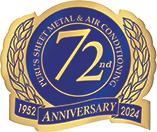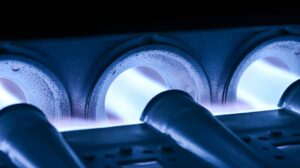The natural gas furnace has been common in homes since the 1940s. Until fairly recently, these furnaces used a standing pilot light to ignite the gas burners at the start of their heating cycle. The pilot light would maintain a small flame throughout the heating season so whenever gas flowed to the burners, the pilot would immediately ignite them.
There are still furnaces in use today that have standing pilot lights, but they’re becoming rarer each year. Most natural gas furnaces have changed over to using electronic ignition systems instead. The reason for the change is to make furnaces more energy-efficient as well as more reliable. A pilot light that burns for the whole winter is an additional drain on natural gas, while an electronic ignition system only needs to use power at the moment it ignites the burners.
How does electronic ignition work? There are two general types of electronic ignition systems found in furnaces: hot surface ignition and intermittent pilots.
Hot Surface Ignition
This is the most common type of ignition in modern furnaces, and it works similarly to an incandescent light bulb. An electric current runs through a metal probe positioned over the burners, and the current causes the probe to turn hot the same way filaments in a light bulb glow hot when current runs through them. When the ignition system is hot enough, gas starts to flow to the burners and the probe lights them. The ignition system then shuts off.
Intermittent Pilot
As the name implies, this system uses a pilot light—but it’s doesn’t stay lit for long. An electric spark causes the pilot light to come on only when there’s a demand for heating. First, the gas line to the pilot assembly opens, then an electric spark ignites the pilot. After a flame sensor detects the pilot light is burning, gas is allowed to flow to burners where the pilot light ignites them. Once the burners are on, the gas to the pilot lights shuts off.
In both types of electronic ignition systems, there are extra safety steps to prevent gas from flowing to the burners when there’s nothing to ignite them. This makes electronic ignition systems safer in general than older standing pilot lights.
Should You Replace a Furnace With a Standing Pilot Light?
This is a good question, and it depends on how old a furnace you have. Because pilot light furnaces are less common today, the furnaces that have them are usually more than 10 years old. We recommend you consider replacing your furnace if it’s older than 15 years. You’ll not only benefit from having an electronic ignition system, you’ll have a furnace with superior energy efficiency and a long life ahead of it.
No matter what furnace service in Fresno, CA you need—repairing a broken electronic ignition system, replacing an older furnace—you can count on our technicians to get the job done right every time.
Call Purl’s Sheet Metal & Air Conditioning when you need service for your home heating system. Uncompromised Quality & Customer Service Since 1952.


